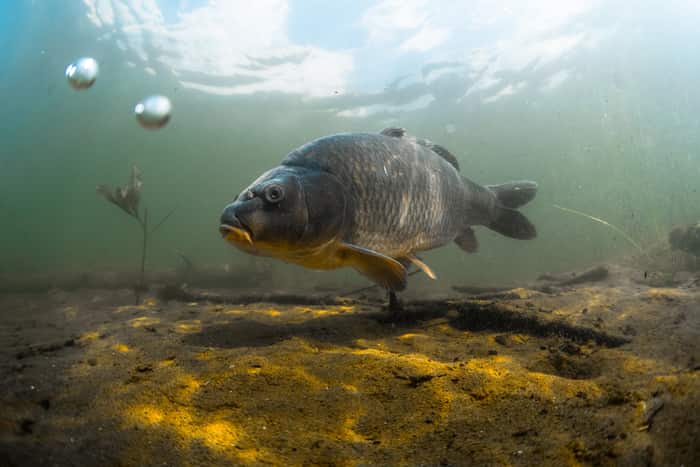Learning how to improve bowfishing accuracy matters because this will have the biggest impact on how many fish you shoot. Over time, your accuracy improves as you learn how to take shots that will skewer the fish to reel them in.
How do you improve bowfishing accuracy? Shoot at underwater targets to practice your bowfishing skills. To do this, you might buy a practice target and shoot at it to get a feel for the real thing. You might also take a sinking soda bottle and use this to practice shooting at.
Practicing on Underwater Targets
One of the first lessons that you learn from bowfishing comes from how the actual fish will appear higher in the water because of refracting light., but you have to aim lower if you want to hit it. If you can miss a couple of shots on a practice target, you won’t miss the actual fish when showtime comes and the real fish shows up.
In using a practice target underwater, you will learn how to aim a little below where the fish appears to hit your mark. You succeed with this from practice and doing it a lot. While you may not hit your target every time, you sure will have a lot of fun doing it every time.
Why Backyard Practice Won’t Improve Your Accuracy
I don’t recommend that you shoot arrows in your backyard at a target because the nature of this sport differs from regular target practice. You have to take the refraction of light into consideration. Setting this up underwater, you keep practicing it until it becomes secondhand nature to shoot the fish in this way.

Improving Accuracy through Different Targets
If you want to start with a little bigger target, instead of a plastic soda bottle, you might use a submerged plastic milk jug. The milk jug gives you a little bigger target to start shooting at.
While it’s a fairly expensive product for target practice, you could also buy the Rinehart Targets Gar Target. This was intended more for the diehard bow fisherman who wants the shots to resemble a real-life underwater scenario.
As you train on the practice target, you will move it to various depths to keep practicing your shots with light refraction. This will teach you how to aim for different depths. Normally, with bowfishing, you will be shooting in water between 2 feet to 5 feet deep, and you will want to practice in water between these depths to get a feel for it. At different depths, you will have to aim for different places. The deeper the fish, the lower that you will have to aim. The farther away that the fish is, the lower that you will have to aim as well. It takes mental calculation to get started, and while you might feel frustrated in the beginning, you will eventually get better so that you can accurately hit 30 to 40 carp a night.
From practice, you can figure out what gear works and what doesn’t work. When you prepare ahead of time, you won’t miss shot after shot when the real fish show up. Your accuracy will be lethal.
Practice Bowfishing from a Boat and Bowfishing from Wading
Depending on how you plan to bowfish, you will either want to practice while wading in water or while on a boat. The thing to remember with both types of practice is that the angles for the shots will differ for each. You want to practice more with the type of bowfishing that you plan to participate in. However, it can be useful to practice both up to a degree to become familiar with shooting in both environments.
On the boat, many of the shots taken will be almost underneath the boat as the fish skitter around, and you have to learn how to make these shots at downward angles. Wading out into the water presents you with different types of shots as the fish will be further out.
Shots at Fish Tend to Be Closer
When you go to take a shot at a fish, the shots tend to be closer than with deer hunting. You’d think it’d be easy to shoot the fish, but because of light refraction in the water, you could struggle to hit your target if you haven’t practiced for pinpoint accuracy. In addition, the angle of the shot tends to make shooting fish a little more difficult.
Doing a practice session helps you to see how your equipment performs and what works with it and what doesn’t.
Improving Your Child’s Accuracy
One of the most common problems from a child making shots comes from the guard rail on the bowfishing boat. Having a lower limb or cam touching the rail can misdirect the shot and make it harder for a child to make the shot. You want to put your child in a test environment so that they can practice this and learn how to shoot with it in the way.
To combat this problem, you might also start them out with wading practice. As they get better off the boat, move them onto the boat to learn how to take the shots on the water.
An advantage of bowfishing comes from the fact that you will take many more shots than what you would with regular bow hunting. You have more opportunities to practice your shots and get deadly accurate on the water.
Regular Arrows vs. Bowfishing Arrows
With regular arrows, you have fletching on it to take further shots at deer and other animals. Bowfishing, on the other hand, uses no feathers because of how the shots tend to be up close, so it wouldn’t even do much good. The arrows are also heavier to deal with the impact from the water and keep it accurate.
Fiberglass arrows are typically preferred with bowfishing because of how they weigh more than the other types of arrows. While fiberglass arrows aren’t fancy, they get the job done for bowfishing. The brightness of a fiberglass arrow also allows for easier tracking underwater after you have shot a fish.
Carbon arrows, relatively new to the bowfishing scene, tend to be straighter, and you can recover them more quickly than with other arrows. In addition, carbon arrows tend to have better accuracy, and this is why they’re often used in archery tournaments. They also blow straight through the water, which can be advantageous. However, the biggest disadvantage of carbon arrows comes from the fact that they will cost a lot more than their fiberglass counterpart. Many bow fishermen think that fiberglass does a good enough job in the water, but that’s up to opinion.
Put on Some Polarized Glasses for Better Accuracy
One of the simplest ways that you can improve your bowfishing accuracy comes from putting on some polarized glasses. In particular, you will want to use polarized glasses during the day more than at night because you have the bowfishing lights you can use at night.
The quality of polarized glasses varies greatly from one to the next. Also, I wouldn’t recommend that you buy this product online because you need to see what each pair of glasses feels like on your head. You can only do this by visiting a place in person to learn what works for you and what doesn’t.
Under the ideal circumstances, you will completely forget that you’re wearing polarized glasses, but they will help you to see the fish underwater so that you can make more accurate shots. Having a good strap can keep them on your head. You don’t want to pay between $50 to $100 only to have the glasses sink to the bottom of the lake.

Have Your Bow Sighted in for Perfection
While it may sound fairly obvious, you can improve your accuracy simply from making sure that you have sighted your bow in, and it is dead on. It may take some time, but it is well worth doing for the increased accuracy and fewer missed fish. You may even want to check this every couple of days because of how your shooting form can change from one day to the next.
How do you sight in your bow for better accuracy? You can ask the ask the archery shop to do this for you, but you can also try your own hand to make sure that you have a deadly accurate shot on those carp in the water. No one will make sure it is more accurate than you, and you will teach yourself a valuable skill at the same time.
To begin sighting in your bow, you will most likely need a few days because of how your form can change from day to day. With this type of fishing, you don’t use a bow sight. You look past the string and straight down the arrow to see where it is aiming.
Next, you will set up your target from 10 yards all the way to 40 yards. As you shoot it, take note of where the arrow hit in comparison to where the pin showed. You make the adjustment and improve your shots in the process. However, you shouldn’t worry too much about an absolutely perfect sighting in because of how the pin will most likely change with time. This is one of the ways that you can get better accuracy while on the water.
Making sure that you have your bow tuned for hitting the fish can go a long way, and it’s one of the ways to improve your hit-to-miss ratio.
Practice Having a Smooth Draw
With bowfishing, one of the things that can make or break you comes from having a smooth draw on the water. You don’t want it to feel all jerky as you pull back on the bow because this can mess up your accuracy. You will hit more fish from a smooth draw and release. When you go to release the string, you want the release to feel smooth on the hand as well. This will guide the arrow better to your target.
Draw weight can have an impact on a smooth draw, and in some cases, you may want to lower the draw weight a little if you can’t get a smooth draw. Typically, anywhere from 35 to 50-pound draw weight will be good for bowfishing. You will want it higher for some of the more armored fish. Shooting a bow that is too heavy on the muscles can put the kiss of death on your shooting accuracy. With really shallow water, you might only need 20-pound draw weight so that the arrow doesn’t get sunk deep into the mud.
As you draw back, you don’t want to dip the arrow or point it in the air. You also don’t want the bow to move forward. You want a nice smooth draw that will lead to a soaring and accurate release. To start, this may be a little easier with a compound bow, rather than a recurve because of how you don’t have to shoot with the full draw weight. Practice makes perfect.
Use Two-Barb Tipped Arrows to Start
Granted, having a three-barbed arrow tip can put the arrow in the fish, and it won’t be likely to get away, this can also make the release more difficult. Especially with more armored species like the gar, that’s a good thing when you shoot the fish, but it’s not so good when you’re shooting the arrow deep into fallen trees and other objects more. You will spend more time getting accurate through a big hassle.
With a two-barb tipped arrow, it comes out a little easier, and you can keep practicing your shots without feeling frustrated by it. Three-barbed arrow tips will be a better practice in deep and open water where you need it to penetrate the fish without question.
Use Bottle-Reel Style as You Learn How to Shoot
While learning how to shoot, you may want to begin with bottle-reel style for bowfishing. You have a variety of reels with bowfishing, and the seasoned veterans usually prefer the spincast reels because of a variety of benefits. Using a spincast reel can be counterproductive for a beginner because of how beginners can forget to release the reel and ensure the line doesn’t get tangled. You have too many things to keep track of. In addition, you don’t want the arrow to snap back on you, which has led to serious injuries.
Bottle-reel style doesn’t give you any of these dangers, and it helps you to get acquainted with the bow first when bowfishing. You might have a deadly accurate shot, but you don’t want anything to interrupt it. These are simpler to use for a beginner, and you will reel it in using hand-over-hand pulling it in. It’s old fashioned, but you’ll be much safer when you first get started with bowfishing, which is equally important.
As you get better, you can try out the different reel styles.
Try to Miss the Next Fish Low
The number one mistake that bowfishermen make when it comes to bowfishing comes from not taking light refraction on the water into account. This takes a lot of practice to get used to, but over time, you will improve your shots. One of the recommendations that I will sometimes make to the bowfishermen is to pretend like you’re going to miss the next fish low and shoot lower than what you normally would. This will have a big impact on your accuracy on the water.

You Don’t Have to Draw It All the Way Back
With many bowfishing shots, the fish will literally be right next to the boat or a close shot at less than 20 yards away. This means that you don’t have to draw the bow all the way back. When people try to draw the bow all the way back for a shot, it can lead to them overthinking the shot, and this will ultimately mean that they miss their chance.
Especially with a recurve bow, these bows were made for snap shots, and you don’t need all the power to make the shot. It’s close enough that drawing back a little bit will still give you a shot that skewers the fish. That’s one of the beautiful things about bowfishing. If you can get used to the light refraction, the fish will normally be pretty close for you to make the shots. You’ll find yourself a lot more accurate if you follow this tip.
Practice Shooting at Downward Angles
With bowfishing, all your shots will be taken from a downward angle, and if you can get used to making shots at a downward angle and doing different angles, you can have a big impact on your accuracy. You will find that it’s a good idea to bend your hips for the proper form and shoot at a downward angle.
Taking Light Refraction into Consideration
If you were to dip your arrow into the water, you’d see that it bends as it goes into the water and doesn’t go straight. This is because of what’s known as light refraction, and things will be lower in the water than what they appear.
If you want to have deadly accuracy on the water, when you go to aim, you don’t want the tip of the arrow to be right on the fish. You want it to be below it, and this will take some practice getting used. Most people when they first start bowfishing, if they hit a fish during the first 40 to 50 shots, it means they’re doing pretty good, especially in the beginning.
Hopefully, following some of these guidelines, you can improve your accuracy on the water so that you can shoot more fish. Even if you miss a lot of the fish in the beginning, remember that it takes practice to hit them. In addition, you might take someone out on the water who has experience with this type of fishing so that they can help you to practice effectively and make more shots that hit the fish.

1 thought on “How to Improve Bowfishing Accuracy”